What makes the Sundew one of the most interesting carnivorous plants is that it captures its prey with dew! But its dew is rendered useless without proper sunlight. Without proper light exposure, the dew lacks the mucilage that sticks the prey to the leaves.
Your sundew needs at least 6 hours sun time. On the other hand, too much direct sunlight can dry out your sundew. Sunlight is essential for these plants to produce food and stay healthy and alive. But there is a limit to how much sunlight they should be getting.
Sundew care is in no means hard, but it has some specific requirements when it comes to getting sunlight. Read on if you want the in-depth answer to “how much sun does a sundew need?”. This article also provides a brief overview on whether you can grow sundews indoors or not and how much sunlight it will need then.
How Much Sun Does a Sundew Need?
Just as the name suggests, sundews thrive in the sun. Sunlight is integral to its survival. The brightness of the red in its filaments depends on the amount of sunlight it gets. The redder it is the better its trapping ability.
But how much sunlight it needs on a daily basis depends on many factors. The climate, environment, temperature and humidity all play a part in how much sunlight a sundew needs.
Some sundews can go by with a minimum of 4 hours direct sunlight daily. Some sundews need 6 to 8 hours unobstructed sunlight daily.
Some sundew can do without so much direct sunlight and thrive under indirect sunlight. For example, the lance leaf sundew (Drosera adelae) grows better in low sunlight.
Some sundews even need 12 to 15 hours of sun time. But too much direct sunlight can burn the roots of other sundews.
Do Sundews Need Full Sun?

Most sundews need 6 hours of unobstructed sunlight in the least. That is, most sundews need full sun. It suits sundews best. Some sundews can do with part sun. That is, these carnivorous plants can survive well in 3 to 6 hours of direct sunlight too.
Again, in proper conditions, some sundews do well in dappled or artificial lighting as well. For example, the heart leaf sundew (Drosera schizandra) grows well getting a daily dose of 3 to 4 hours’ sunlight instead of full sun.
Whether you provide part sun or full sun lighting to your sundew, you must not keep it in full shade. Because without light sundews will die.
Can you Grow Sundews Indoors?
Unlike most carnivorous plants, sundews are small and perfect as indoor potted plants. For proper growth, your potted sundew needs to be on a constantly moist soil mix of perlite and sphagnum moss or peat moss. Plus, they grow well at room temperature too.
If you have a nice window sill that provides an ample amount of sunlight, you can grow your sundews indoors. What you have to look out for while growing your sundews indoors is the colour of its filaments.
The problem most people face with their indoors sundew pot is that it loses its trapping ability. The filaments are not red enough or it is not producing enough dew. A huge reason behind this is the light exposure the plant is getting.
Indoors sundews plants need bright indirect light along with at least 4 hours of direct or unobstructed sunlight. Without proper lighting, your potted sundew can be in the risk of dying even.

Sun Light Requirement for Different Species of Sundews
Different species of sundews need a different amount of time in the sun. Some need direct sunlight for hours, some do well in low light.
Forked Leaf Sundew
Drosera Binata or Forked Leaf sundews need a lot of time under the sun. If you get this species of sundews, you will need to keep it outdoors and unobstructed sunlight of 6 hours minimum. If your plant is not producing enough dew, you need to increase its time under the sun.
If you live in a snowy area, keep your sundew in a sunny windowsill. The forked leaf sundew has a winter dormancy so, even if you live in a place it snows, your plant will be okay.
Rosetted Sundew
You can grow Rosetted sundews both indoors and outdoors. But it needs direct full sun. If you plan to grow it indoors, you need to ensure it gets an optimum amount of sunlight.
You will also need to adjust the amount of time it will need under the sun depending on how red its filaments are.
Cape Sundew
Drosera capensis or Cape sundews are the most common and easy to grow sundews. It can thrive in both full sun and part sun lighting.
Cape sundews can be grown indoors as well. But you have to make sure it gets 6 hours of direct sunlight.
Pygmy Drosera
Pygmy Drosera needs a minimum of 6 hours under direct sunlight. You can grow it outdoors or indoors. If you grow it indoors, make sure it is beside a sunny window sill.
If you are unhappy with the dew it is producing, adjust the lighting. You can grow it under artificial lighting too. But you will need to increase its time under the light.
Drosera Regia
If you do not have access to outdoor gardens, you can opt for growing Drosera Regia indoors. They thrive well beside a sunny windowsill.
You can also grow them in a greenhouse or terrarium under fluorescent light. Initially you have to keep the artificial lights at a distance. But decrease the distance between the lights and the sundews later on for better growth.
Drosera Schizandra
Unlike most sundew species, the Drosera schizandra thrives in shaded areas. It needs very little sun time in comparison to other sundews.
You do not have to worry much about providing enough sun time to these sundews. But you have to ensure high humidity levels for it to survive.
Alternative to Sunlight: Fluorescent Lights to the Rescue!
If you do not have the option to grow Sundews outdoors, don’t fret. With proper measures, you can grow your carnivorous plant indoors.
You do not have to worry about your sundews losing its trapping ability or dying due to poor lighting. Even if you do not have a sunny windowsill to nourish your plant pet, you can get fluorescent lights.
Amongst all types of artificial lights, fluorescent lights are the best for growing indoor plants. Unlike incandescent lights, fluorescent lights will not burn your house plant.
Instead, the limited amount of UV rays they emit will speed up the growth of your house plants. Compact fluorescent lights are great for growing carnivorous plants like sundews indoors due to the fact they emit UVA which speeds up the process of photosynthesis and thus mimics the growth of plants outdoors.
If you are considering fluorescent lights for your sundews, I recommend T5 bulbs with 6500K color range. You can also opt for T8 bulbs. Anything between 5500K to 6500K color ranges will do.
At the beginning place your lights 12 to 18 inches above your carnivorous plant. After you get your sundew acclimatized to the indoor lighting, you can fix the lights 6 inches above the plant.
You should monitor your indoor sundews carefully. If you are not satisfied with the plants coloring or dew production you should change the lighting. Your indoor sundew pot will require around 14 hours of artificial lighting.
As far as I’ve noticed, sundews grow healthy whether it be natural or artificial light. With proper precautions you do not need to worry about growing them unnaturally.
Final Thoughts on How Much Sun Does a Sundew Need
Hopefully this will showcase the ability to grow your sundew anywhere you want as long as you provide it quality access to sun and fun! If not definitely take a dive into indoor lighting to make sure it can grow and thrive on!




Leave a Reply